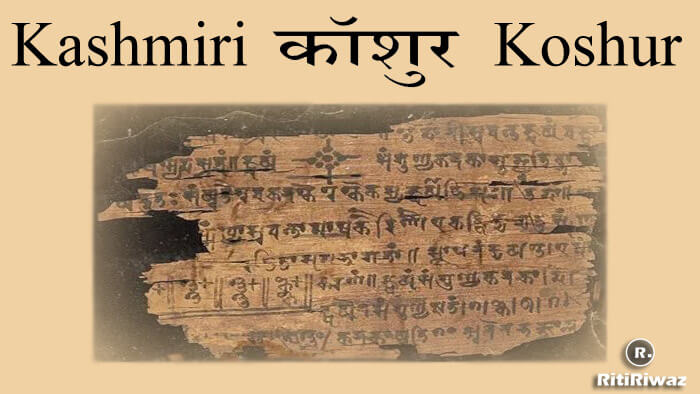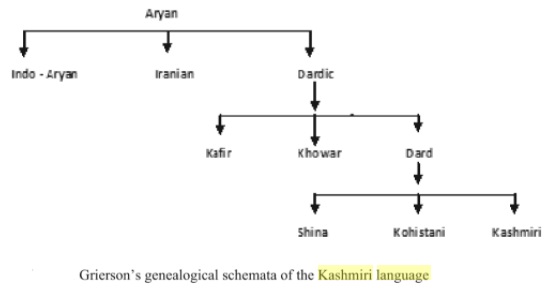Kashmiri Language | Koshur

Kashmiri language or Koshur is an Indo – Aryan language and is generally regarded as the oldest language of Dravidian family languages of the Indian subcontinent. Although Sanskrit is considered to be on par with Kashmiri from the point of view of age. It is primarily spoken in the Kashmir valley of the Jammu and Kashmir state of India and also in parts of Azad Kashmir in Pakistan.
Kashmiri is written from Right to Left, similar to Hebrew, Arabic, and Urdu languages. Urdu is the official language of Jammu and Kashmir but Standard Kashmiri, spoken in the city of Srinagar, is employed in elementary education, mass media, and literature. Language usage is affected by religious and social differences, namely between Hindus and Muslims, between the cities and the countryside.

Language Family: Kashmiri is a Dardic language and belongs to the Dardic sub-group that comes under the Indo-Aryan family of the Indo-European language family. Dardic languages are spoken in Gilgit, Pakistan, and northern regions of Kargil.
Script: Traditional, Koshur was written in Sharada script after the 8th century A.D. However, it is no more used now and has been replaced by Devanagari and Perso-Arabic scripts. The Perso-Arabic script has become associated with Kashmiri Muslims while Devanagari script got inclined to Kashmiri Pandits.
History

According to historical linguists, Kashmiri belongs to the Dardic branch of the Indo-Aryan family. Kashmiri is closely related to Sindhi and some other languages of the North-West frontier. It also shares some morphological features such as pronominal suffixes with Sindhi and Lahanda. Separated from the main Indo-Aryan languages and close to the Iranian world, Kashmiri preserved some archaic features while developing unique traits at the phonological, morphological, and syntactical levels.
From 1820 to 1947 the entire Kashmir region was governed by Hindu maharajas from the Dogra dynasty. In 1947, when the British colonizers left the Indian subcontinent, the last maharajah, Hari Singh, “hoped his kingdom would remain independent. It was a territory unified over many centuries by a common language, Kashmiri (a Dardic language spoken in India and Pakistan), but it was also made up of many micro-identities with their own dialects,”
The earliest record of Kashmiri is a group of 94 stanzas embedded in the Mahānaya-prakāśa (‘Illumination of the Highest Attainment’), a Sanskrit philosophical work dating from the 14th-15th century. Kashmiri, though spoken by the dominant majority of people in the valley, has never been used as an official language in its home state i.e. Jammu and Kashmir. Persian was introduced as the official language during the Muslim rule beginning the 14th century, which was later replaced by Urdu, another non-native language even after independence.
Kashmiri is spoken in Pakistan too in the area of Azad Kashmir. In India, Kashmir is one of the 22 scheduled languages and most Kashmiri speakers use Urdu and English as their second language. Since 2008 Kashmiri language is made a compulsory language in all government schools in the valley.
Suggested Read: Jammu Kashmir – Culture and Tradition
Kashmiri Dialects
Kashmiri has two types of dialects. 1. Regional dialects 2. Social dialects. Regional dialects are further of two types 1. Those regional dialects or variations which are spoken in the regions inside the valley of Kashmir 2. Those which are spoken in the region outside the valley of Kashmir.The Kashmiri speaking area in the valley is ethno-semantically divided into three regions. 1. Maraz (southern and southeastern region) 2. Kamraz (northern and northwestern region) 3. Srinagar and its neighboring areas.
There are some minor linguistic variations mainly at the phonological and lexical levels. Kashmiri spoken in the three regions is not only mutually intelligible but also quite homogenous. These dialectical variations can be termed as different styles of the same speech. Since spoken in and around Srinagar has gained some social prestige, very frequently ‘style switching’ takes place from Marazi or Kamrazi styles to that of the style of speech spoken in Srinagar and its neighboring areas. This phenomenon of style switching is very common among the educated speakers of Kashmiri. Kashmiri spoken in Srinagar and surrounding areas continues to hold the prestige of being the standard variety which is used in mass media and literature.
Kashmiri has two main regional dialects, namely Poguli and Kashtawari spoken outside the valley of Kashmiri. Poguli is spoken in the Pogul and Paristan valley bordered on the east by Rambani and Siraji and on the west by mixed dialects of Lahanda and Pahari. Kashtawari is spoken in Kashtawar valley, lying to the southeast of Kashmir, Bhadarwahi borders it on the south. Chibbali and Punchi to the west and Tibetan speaking region of Zanskar on the east.
Suggested Read: Kashmiri Carpets
Kashmiri literature
Kashmiri literature has a history of at least 2,500 years, going back to its glory days of Sanskrit. Early names include Patanjali, the author of the Mahabhashya commentary on Pāṇini’s grammar, suggested by some to have been the same to write the Hindu treatise known as the Yogasutra, and Dridhbala, who revised the Charaka Samhita of Ayurveda.
In medieval times the great Kashmir Valley School of Art, Culture, and Philosophy Kashmir Shaivism arose. Its great masters include Vasugupta (c. 800), Utpala (c. 925), Abhinavagupta, and Kshemaraja. In the theory of aesthetics, one can list the Anandavardhana and Abhinavagupta. Many generations later, in our modern times, a new lease of life given, to the same “school of thought” was given by Swami Lakshman Joo of Ishbher/Gupta Ganga, Srinagar, India.
The use of the Kashmiri language began with the poet Lalleshvari or Lal Ded (14th century), who wrote mystical verses. Another mystic of her time equally revered in Kashmir and popularly known as Nunda Reshi wrote powerful poetry like his senior Lal Ded. Later, came Habba Khatun (16th century) with her lol style. Other major names are Rupa Bhavani (1621-1721), Arnimal (d. 1800), Mahmud Gami (1765-1855), Rasul Mir (d. 1870), Paramananda (1791-1864), Maqbool Shah Kralawari (1820-1976). Also the Sufi poets like Shamas Fakir, Wahab Khar, Soch Kral, Samad Mir, and Ahad Zargar. Among modern poets are Ghulam Ahmad Mahjur (1885-1952), Abdul Ahad Azad (1903-1948), and Zinda Kaul (1884-1965).
During the 1950s, a number of well-educated youth turned to Kashmiri writing, both poetry and prose, and enriched modern Kashmiri writing by leaps and bounds. Among these writers are Dinanath Nadim (1916-1988), Rahman Rahi, Ghulam Nabi Firaq, Ali Muhammed Shahbaz, Mushtaq Kashmiri, Amin Kamil (1923-) [1], Ali Mohd Lone, Akhtar Mohiuddin, Som Nath Zutshi, Muzaffar Aazim [2], and Sarvanand Kaul ‘Premi’. Some later day writers are Hari Krishan Kaul, Majrooh Rashid, Rattanlal Shant, Hirdhey Kaul Bharti, Rafiq Raaz, Tariq Shehraz, Shafi Shauq, Nazir Jahangir, M H Zaffar, Shenaz Rashid, Shabir Ahmad Shabir, Nisar Azam, Javaid Anwar, Shabir Magami,'[3], Moti Lal Kemmu (playwright).
Contemporary Kashmiri literature appears in Sheeraza published by the Jammu & Kashmir Academy of Art, Culture and Languages, Anhar published by the Kashmiri Department of the Kashmir University, and an independent magazine Neab International Kashmiri Magazine — http://www.neabinternational.org published from Boston, Vaakh an independent publication and Koshur Samachar.
Suggested Read: he Kashmir Problem
